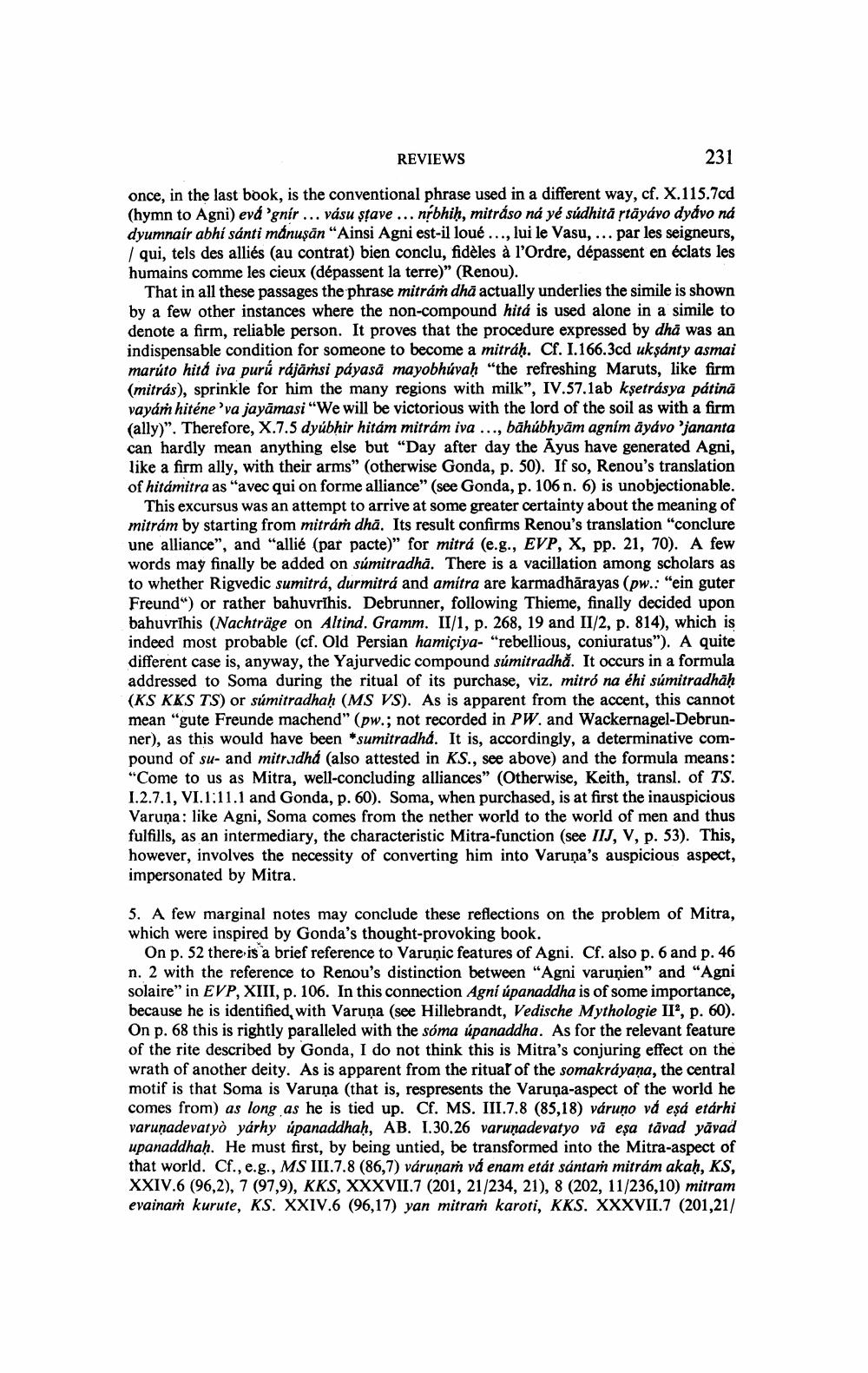________________ REVIEWS 231 once, in the last book, is the conventional phrase used in a different way, cf. X.115.7cd (hymn to Agni) eva 'gnir ... vasu stave ... nrbhih, mitraso na ye sudhita stayavo dyavo na dyumnair abhi santi manusan "Ainsi Agni est-il loue ..., lui le Vasu, ... par les seigneurs, , qui, tels des allies au contrat) bien conclu, fideles a l'Ordre, depassent en eclats les humains comme les cieux (depassent la terre)" (Renou). That in all these passages the phrase mitram dha actually underlies the simile is shown by a few other instances where the non-compound hita is used alone in a simile to denote a firm, reliable person. It proves that the procedure expressed by dha was an indispensable condition for someone to become a mitrah. Cf. I.166.3cd uksanty asmai maruto hita iva puru rajamsi payasa mayobhuvah "the refreshing Maruts, like firm (mitras), sprinkle for him the many regions with milk", IV.57.1ab ksetrasya patina vayam hitene 'va jayamasi"We will be victorious with the lord of the soil as with a firm (ally)". Therefore, X.7.5 dyubhir hitam mitram iva ..., bahubhyam agnim ayavo 'jananta can hardly mean anything else but "Day after day the Ayus have generated Agni, like a firm ally, with their arms" (otherwise Gonda, p. 50). If so, Renou's translation of hitamitra as "avec qui on forme alliance" (see Gonda, p. 106 n. 6) is unobjectionable. This excursus was an attempt to arrive at some greater certainty about the meaning of mitram by starting from mitram dha. Its result confirms Renou's translation "conclure une alliance", and "allie (par pacte)" for mitra (e.g., EVP, X, pp. 21, 70). A few words may finally be added on sumitradha. There is a vacillation among scholars as to whether Rigvedic sumitra, durmitra and amitra are karmadharayas (pw.: "ein guter Freund") or rather bahuvrihis. Debrunner, following Thieme, finally decided upon bahuvrihis (Nachtrage on Altind. Gramm. II/1, p. 268, 19 and II/2, p. 814), which is indeed most probable (cf. Old Persian hamiciya- "rebellious, coniuratus"). A quite different case is, anyway, the Yajurvedic compound sumitradha. It occurs in a formula addressed to Soma during the ritual of its purchase, viz. mitro na ehi sumitradhah (KS KKS TS) or sumitradhah (MS VS). As is apparent from the accent, this cannot mean "gute Freunde machend" (pw.; not recorded in PW. and Wackernagel-Debrunner), as this would have been *sumitradha. It is, accordingly, a determinative compound of su- and mitradha (also attested in KS., see above) and the formula means: "Come to us as Mitra, well-concluding alliances" (Otherwise, Keith, transl. of TS. I.2.7.1, VI.1:11.1 and Gonda, p. 60). Soma, when purchased, is at first the inauspicious Varuna: like Agni, Soma comes from the nether world to the world of men and thus fulfills, as an intermediary, the characteristic Mitra-function (see IIJ, V, p. 53). This, however, involves the necessity of converting him into Varuna's auspicious aspect, impersonated by Mitra. 5. A few marginal notes may conclude these reflections on the problem of Mitra, which were inspired by Gonda's thought-provoking book. On p. 52 there is a brief reference to Varunic features of Agni. Cf. also p. 6 and p. 46 n. 2 with the reference to Renou's distinction between "Agni varunien" and "Agni solaire" in EVP, XIII, p. 106. In this connection Agni upanaddha is of some importance, because he is identified, with Varuna (see Hillebrandt, Vedische Mythologie II, p. 60). On p. 68 this is rightly paralleled with the soma upanaddha. As for the relevant feature of the rite described by Gonda, I do not think this is Mitra's conjuring effect on the wrath of another deity. As is apparent from the ritual of the somakrayana, the central motif is that Soma is Varuna (that is, respresents the Varuna-aspect of the world he comes from) as long as he is tied up. Cf. MS. III.7.8 (85,18) varuno va esa etarhi varunadevatyo yarhy upanaddhah, AB. I.30.26 varunadevatyo va esa tavad yavad upanaddhah. He must first, by being untied, be transformed into the Mitra-aspect of that world. Cf., e.g., MS III.7.8 (86,7) varunam va enam etat santam mitram akah, KS, XXIV.6 (96,2), 7 (97,9), KKS, XXXVII.7 (201, 21/234, 21), 8 (202, 11/236,10) mitram evainam kurute, KS. XXIV.6 (96,17) yan mitra karoti, KKS. XXXVII.7 (201,21/




